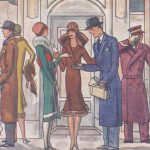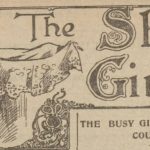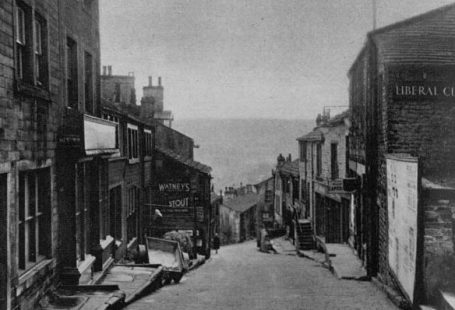This week at The Archive we are excited to bring you 95,362 brand new pages, which span over 200 years of headlines. Meanwhile, we have added five new titles, from Swanage to Sheffield, and South London, and we continue to tell the story of the British Empire, and the struggle for independence from the Empire, with the addition of India, the original organ of the Indian National Congress.
So read on to discover more about our new titles of the week, as well as to discover which of our thirteen existing titles we have updated over the past seven days. Also, we explore the pages of India and look at early mentions of Mahatma Gandhi, and how he advocated for the rights of Indians living in South Africa in the 1890s and 1900s.
Register now and explore the Archive
Our first new title of the week is India, and it joins our collection of international titles, from the likes of Jamaica, Canada, and Pakistan, which tell the often confronting story of the British Empire, and the story of these countries’ struggle for independence. And no more important title to tell this story is India, which was first published on 1 February 1890 and described itself as a ‘A Journal for Discussion of Indian Affairs.’

Published in Calcutta (now Kolkata), West Bengal, which was India’s capital under the British Raj from 1773 to 1911, India was established ‘To advocate India’s native claims.’ It was the organ of the Indian National Congress, which was the first modern nationalist movement to emerge in British ruled parts of Africa and Asia. The Indian National Congress (or INC) was founded in 1885, and aimed to achieve a greater share in the government of India for educated Indians.
Indeed, the first page of the first edition of India contained this rallying message:
While the English mind in India has been tempted to stand still, arrested by the contemplation of the fruits of its efforts in former times, and by the symmetry of the shrine, the pride of its own creation, in which it lingers to offer incense to its past successful labours, the Indian mind has been marching on, eager and anxious to expand its own sphere of action, and to do what it, for its own part, has to do.
And in its battle for equality, and eventual independence, India stated its peaceful intent, foreshadowing the rationale of Mahatma Ganda, who would later become President of the INC:
Unshaken determination and unsparing effort will be the only weapons in this warfare so far as we are concerned.

So what did the pages of India contain? Costing two pence, and published every fortnight, the newspaper contained extensive details on the INC, including detailed looks at the various committees of the organisation and its meetings, often including illustrations of its members, including ‘Two of the Lady Delegates’ at a meeting held in Bombay (Mumbai). Meanwhile, the publication took at look at how the INC was being received outside of India, with it being reported in 1890 that the organisation was ‘becoming a household word in England.’
India also took a look at happenings in British Parliament and how they affected the country, as well as containing such articles as ‘Why Conservatives Should Support the Indian Congress’ and ‘The Reform of the Legislative Councils.’ It also took a humorous look at contemporary happenings, including a column entitled ‘Comments on the Congress: Wise and Otherwise.’ Meanwhile, India featured journalism by Indian writers, and poetry by Indian poets, and a list of Indian reform literature.
From the early 1900s onwards the INC slowly became more radical, and when lawyer Mahatma Gandhi returned to India from South Africa in 1915, he became more affiliated with the party, becoming its president in 1924. The INC survives today as one of India’s two major political parties, and played a principal part in gaining independence for the country, leading the way for other anti-colonial nationalist movements across the British Empire.
We return now to England for our next new titles of the week, including two from London’s south. First up is the South London Mail, a local newspaper dedicated to advocating the interests of the Conservative party. Circulating in the ‘Political Divisions of Camberwell, Peckham, Dulwich, Walworth, Newington, Lambeth, Rotherhithe, Bermondsey, Deptford & c.,’ the South London Mail was first published on 28 January 1888, at the cost of just one penny.

Consisting of eight pages, the South London Mail hoped to be ‘heard in all Political districts in which it circulates.’ Its supporters, including John Howard, who spoke at North Camberwell Conservative Club, expressed their belief that ‘every Conservative would be thoroughly well satisfied with the paper,’ as it was intended to be a ‘sound…and ably conducted journal.’ Meanwhile, the inaugural edition of the South London Mail proclaimed that it would go beyond party parameters, to:
…become a factor for good in South London; in addition to the advocacy of Conservative politics, our columns are always open for the discussion of social questions.
Contained within the pages of the South London Mail are copious reports from the various Conservative clubs across South London, such as the Camberwell, Peckham and Dulwich Conservative Club, as well as portraits of important local Conservative personalities. The newspaper also contained local news from the likes of the Lambeth County Court and the Camberwell Board of Guardians, as well as general interest features, which included a ‘Ladies’ Column,’ and columns entitled ‘Bits from Books, ‘Cuttings from the Comics’ and ‘Daily Kindnesses.’
Our second South London title of the week is the Bromley & West Kent Mercury, which was first published from Bromley Market Place on 16 May 1919, at the cost of one penny. Appearing every Friday, this local newspaper proclaimed that it contained four photographs, and its first edition expressed the need that Bromley had for a new newspaper:
…there is what is known commercially as a good opening for a new weekly newspaper in this district. There is reason to believe that of thousands of residents in Bromley and the adjacent towns and villages, a very large percentage of which, at present, neither purchase nor take the trouble to read a local journal, and we hope to make the ‘Mercury’ sufficiently attractive [to them]…

Moreover, the Bromley & West Kent Mercury hoped to be ‘for the benefit of Bromley as a whole,’ all the while ‘stimulating [a] healthy concern in the affairs of the neighbourhood,’ becoming ‘something in the nature of a friend.’ Indeed, Bromley by 1919 was something of a boom town, the opening of a railway station in 1858 key to its development, and its new newspaper faithfully chronicled the area’s local news, including the latest from Bromley County Court, Bromley Borough Council and Bromley Deanery, whilst also looking at local accidents and thefts.
The first year of the newspaper shines a light on life in post First World War Bromley, with a look at the planning of the town’s war memorial, and a club for ex-soldiers, as well as exploring the rise of the local Labour party. The Bromley & West Kent Mercury also looked at the local churches, and ‘Fashions and Things Feminine,’ whilst also containing letters to the editor and notices of births, marriages and deaths.
We travel to Dorset now and the seaside resort of Swanage for our next new title, which is the Swanage Times & Directory. The coastal town had become an immensely fashionable resort in the Victorian era, and this newspaper made its debut in the same year as the Bromley & West Kent Mercury, its first edition appearing on 6 September 1919.
Describing itself as ‘The Official Newspaper for Swanage and District,’ the first edition of the Swanage Times & Directory explained how:
Swanage needs its own local paper, – a medium for the circulation of news in the town and neighbourhood and a vehicle for the advocacy of interests, which year by year are growing in number, variety and importance.

Indeed, it expressed its intention to model itself from the Bournemouth Directory, another local newspaper, which was found in 1858, when the town had a smaller population than Swanage possessed by 1919. The Swanage Times & Directory, therefore, hoped to ‘give from week to week a full and reliable record of local happenings,’ with its editorial columns being ‘open for the advocacy of local interests.’
So what did the Swanage Times & Directory feature? It covered an array of ‘Local Topics,’ including a gossipy column entitled ‘The Diary of a Man About Town,’ which looked at local cases of drunkenness and shoplifting, as well as the latest from the Christchurch Guardians, local churches, the licensing sessions, and the Bournemouth Rotary Club. The newspaper also had a focus on the area’s sport, looking at tennis, football and croquet, with features on Christchurch Sailing Club and the Poole Rowing Club.
Meanwhile, the Swanage Times & Directory also took at look at the town’s ‘Health Record,’ and featured extensive reporting on ‘Local Weddings.’
Our final new title of the week is our most historic, and it is the Sheffield Public Advertiser, which was first published on 29 April 1760, running till 1797. Appearing every Thursday at the cost of three pence, the newspaper had a focus on ‘Foreign Affairs,’ reporting on news from across Europe, from Prague, Hamburg and the Hague, as well as from further afield, from the United States and Canada.

The Sheffield Public Advertiser also featured the latest from London, as well as ‘Country News,’ from the likes of Wolverhampton and Cambridge. Elements relating to Sheffield and the surrounding area can be found in the publication’s advertisements, which filled the last page, and contained details on items to be sold, for example, or ‘Stray’d or Convey’d’ horses.
That’s it from our five new titles of the week, meanwhile we have updated a lucky thirteen of our existing titles. A particular highlight of the week are the over 30,000 pages we have added to the Liverpool Journal of Commerce, which span the years 1861 to 1905. We have also added over 13,000 pages to the Newark Advertiser, with the years added covering nearly one hundred years from 1879 to 1968. Another important update this week are the over 6,000 pages we have added to the Lancashire Evening Post.
Gandhi’s Early Activism
With the addition of India to The Archive this week, we scoured its pages to find early mentions of Mahatma Gandhi, and his activism. It was not, however, in India that Gandhi’s activism started, although it was on behalf of Indians, who were, like himself, living in South Africa.
At the age of just 23, in 1893, Gandhi had travelled to South Africa to work as a lawyer, and he immediately suffered discrimination there, on account of his race. Four years later, in April 1897, we found this report in India, regarding ‘Indians in South Africa:’
Mr. M.K. Gandhi, who recently visited India, laid before his fellow-countrymen the disabilities and indignities under which Indians suffer, and the whole case was presented to Lord George Hamilton last December in an incisive memorial drawn up by Mr. Pherozeshah Mehta.

The article went on to outline the kind of discrimination to which Indians in South Africa were subjected:
Throughout South Africa British Indian subjects of the Crown are not only subjected to the most humiliating indignities by European colonists, but are harassed by legal disabilities of the most vexatious and injurious kind. Indians, for example, cannot travel on the railways or tramways without frequent molestation. In some parts of South Africa they are prohibited by law from travelling in any class but the third class. They are pushed off footpaths, excluded from the public baths and Government schools.
It was observed at the time, that, ‘altogether, the Indian is a hated being throughout South Africa; he is shunned as a pariah.’ And Gandhi was not about to stand by and let this happen. Fast forward eleven years to January 1908, and India reports on the arrest of ‘Mr. Gandhi, the well-known Indian barrister,’ alongside eight other Indians for ‘failing to register under the new Asiatic Registration Act.’ Gandhi was arrested on 27 December 1907, and a day later, having been paroled, he addressed a ‘mass meeting of Indians…to protest against the Immigration Restrictions Act.’

Gandhi addressed the meeting, and lambasted the Act as a ‘barbarous and savage measure, although it had been passed by an avowedly Christian Government.’ He also declared how the Act had ‘unduly strained Indian loyalty,’ whilst stating how ‘the British Government had arrived at a parting of the ways, and must choose between India and the colonies.’
By September 1908 India reports how Mr. M.K. Gandhi is ‘clearly’ recognised as the leader of ‘something like 150,000 Asiatics in South Africa,’ where he had been ‘leading the passive resisters, fighting the Government, [and] endeavouring to arrange compromises.’ During his time in South Africa, Gandhi developed his political views and ethics, which would help shape his fight for Indian independence upon his return to his home nation.

India reports on Gandhi’s return in January 1915, in this short paragraph:
Mr. and Mrs. Gandhi arrived at Bombay on January 9, and (says a ‘Daily Chronicle’ cable) are being enthusiastically fêted. It has been announced by Mr. Gandhi that it is his intention of settling in India and devoting his services to the country as a follower of Mr. Gokhale.

With the benefit of hindsight, we can truly see today what a momentous arrival this was, and the absolute import of Gandhi’s decision to return and fight for independence in India, becoming in the process a true icon of peaceful protest and the struggle for self-determination.
New Titles
Title |
Years Added |
| Bromley & West Kent Mercury | 1919, 1921, 1927-1930, 1933-1950 |
| India | 1890-1921 |
| Sheffield Public Advertiser | 1760-1763, 1768, 1770, 1772, 1774, 1776, 1787, 1790-1793 |
| South London Mail | 1888-1906 |
| Swanage Times & Directory | 1919-1936 |
Updated Titles
This week we have updated thirteen of our existing titles.
You can learn more about each of the titles we add to every week by clicking on their names. On each paper’s title page, you can read a FREE sample issue, learn more about our current holdings, and our plans for digitisation.
Title |
Years Added |
| Barrow Herald and Furness Advertiser | 1875, 1891 |
| Cambria Daily Leader | 1897, 1911 |
| Glasgow Courier | 1851, 1856 |
| Lancashire Evening Post | 1911-1915 |
| Lancaster Standard and County Advertiser | 1897 |
| Liverpool Journal of Commerce | 1861-1862, 1864-1867, 1869, 1871, 1890-1891, 1897, 1899-1905 |
| Macclesfield Courier and Herald, Congleton Gazette, Stockport Express, and Cheshire General Advertiser. | 1844, 1858-1859, 1877, 1891 |
| Newark Advertiser | 1879-1891, 1897, 1905, 1908-1909, 1911, 1914, 1917, 1958, 1963, 1966-1968 |
| Northern Weekly Gazette | 1876, 1913 |
| Porthcawl Guardian | 1958 |
| Swansea and Glamorgan Herald | 1869 |
| West Ham and South Essex Mail | 1928 |
| Weymouth Telegram | 1874, 1876, 1879-1881 |
You can keep up to date with all the latest additions by visiting the recently added page. You can even look ahead to see what we’re going to add tomorrow.






